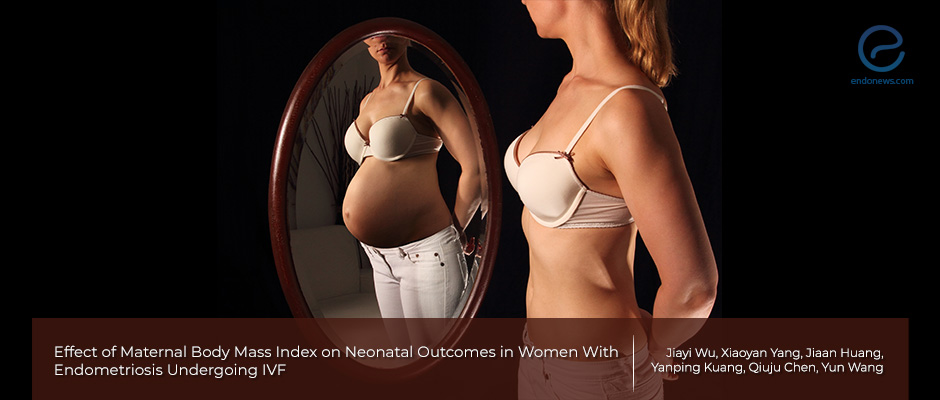Maternal body mass index and neonatal outcomes in women with endometriosis
May 7, 2020
Underweight endometriotic women have a higher risk of preterm birth compared to those without endometriosis.
Key Points
Highlights:
- There is a correlation between pre-conceptional maternal low body mass index and preterm birth in women with endometriosis undergoing in vitro fertilization treatment.
Importance:
- Women with endometriosis should be appropriately informed before IVF treatment about the increased preterm birth risk for those who are underweight.
What’s done here?
- This retrospective cohort study was conducted in the Department of Assisted Reproduction of Shanghai Ninth People’s Hospital.
- Patients undergoing in vitro fertilization treatment due to histopathologically confirmed endometriosis (n=1111), and patients undergoing in vitro fertilization treatment due to tubal factor or male-factor in the non-endometriosis group (n= 5975) were compared.
- All patients were also divided into subgroups based on their pre-conceptional maternal BMI: underweight, normal, and overweight/obese groups.
- The primary neonatal outcome was preterm birth. Other poor obstetric outcomes including early preterm birth, low birth weight, macrosomia, small for gestational age,... were also analyzed.
Key results:
- In the endometriosis group, 504 women (45%) had an ovarian disease and the remaining 607 women (55%) had pelvic endometriosis.
- Women with endometriosis were more likely to have preterm birth and lower gestational age.
- In the underweight group, there was an association between endometriosis and preterm birth and lower gestational age.
- In the normal and overweight/obese groups, no statistically significant association was observed between endometriosis and primary outcomes.
- Other neonatal outcomes did not show any significant association with endometriosis and any category of pre-conceptional maternal body mass index.
Strengths and Limitations
- The retrospective design can be accepted as the limitation of this study.
- Laparoscopy was not performed to exclude endometriosis in all patients in the control group.
- The large sample size, strict inclusion criteria, and control for many baseline characteristics are the strengths of the study.
- Providing a guide to the clinicians about the pre-conceptional weight control of the patients with endometriosis is another strength of this study.
Lay Summary
Endometriosis is defined as the localization of endometrial glandular and stromal-like tissue outside the uterine cavity. Its prevalence is 10-15% in the general population of this age. However, endometriosis is diagnosed more frequently in infertile women with a prevalence of 25-40%.
Infertility in women with endometriosis is managed most commonly by assisted reproductive technology (ART) modalities. The recent literature provides controversial data about the obstetric outcomes of in vitro fertilization treatments in patients with endometriosis. The increased risk of preterm birth and small for gestational age was determined in two recent meta-analyses.
Wu et al, from China, published a study titled “Effect of maternal body mass index on neonatal outcomes in women with endometriosis undergoing IVF” in the journal "Reproductive BioMedicine Online".
The authors aimed to evaluate whether pre-conceptional maternal body mass index may have an effect on obstetric outcomes in the patients with endometriosis undergoing in vitro fertilization treatment, compared to non-endometriosis. A total of 7086 patients met the criteria for the study. Of those, 1111 patients were evaluated in the endometriosis group, while 5975 patients without endometriosis were evaluated in the non-endometriosis group.
They also categorized the patients based on their pre-conceptional maternal body mass index. Preterm birth, early preterm birth, low birth weight, macrosomia, small for gestational age, large for gestational age, very small for gestational age, and very large for gestational age were evaluated as neonatal outcomes. They found that the risk of preterm birth and lower gestational age was increased in the underweight category of the endometriosis group.
The authors proposed two theories for these results, one of which was the increased level of leptin hormone in endometriosis patients. Leptin signaling has importance for weight balance and also inflammation which can result in preterm birth in pregnant women. Another proposed mechanisms were possible genetic factors affecting both endometriosis development and weight control.
“Most importantly, the findings emphasized the importance of women with endometriosis maintaining a normal weight, which should guide obstetricians and gynecologists when managing pregnancy in women with endometriosis and underweight prior to conception, which would be of great significance for clinical practice,” they added.
Research Source: https://pubmed.ncbi.nlm.nih.gov/32171707/
endometriosis pregnancy endo belly body mass index neonatal outcomes preterm birth in vitro fertilization gestational age chronic disease endometrioma tubal factor male factor

